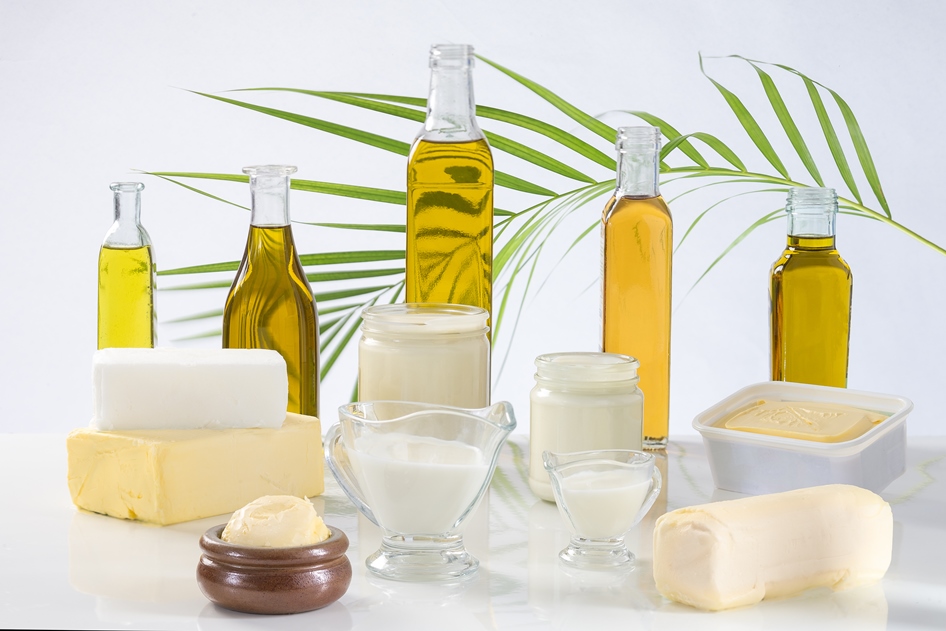Users Who Spiked

THE FACTS ON FAT
Private Notes
Private Notes
Notes
Going Beyond the Nutrition Label
There is a common misconception that all fat is bad. While it may be true that some fats are worse for you than others, there are some fats the body needs. Fat not only provides nutritional benefits, but fat is also involved in many biological processes including providing energy and protection from harming internal organs. Before going into depth, it is important to understand the many different types of fat.
Fats are lipids that are solid at room temperature, while oils are liquid at room temperature. This is due to the lipid structure. The fats and oils we eat are mainly comprised of triacylglycerols, or TAGs for short. This TAG structure has a glycerol backbone, with three fatty acids attached. The differing structures of the fatty acid cause the fat to have different melting points, which is why you see fats and oils behaving differently at room temperature (one is solid, one is liquid). Saturated fatty acids are responsible for the higher melting point of fats (or being solid at room temperature). The more saturated fatty acids in the lipid, the higher the melting point the lipid is. Saturated fatty acids are composed of a long hydrocarbon chain with no double bonds.
Oils on the other hand are completely liquid at room temperature. This is because oils contain significant amounts of unsaturated fatty acids. Unsaturated fatty acids contain a hydrocarbon chain with one or more double bonds. One double bond results in a monounsaturated fatty acid, while two or more double bonds results in a polyunsaturated fatty acid.
Trans-fats have similar melting properties to saturated fats; however, their structure more closely resembles unsaturated fatty acids. Trans-fatty acids contain at least one double bond however the structure of the double bond is different from unsaturated fatty acids. Trans-fatty acids have a double bond that is in the trans formation rather than the cis formation seen in unsaturated fatty acids.
Are these fats healthy?
This answer is complex. Research has shown the negative health effects of saturated and trans-fats. These negative health effects include increasing risk of developing cardiovascular disease, high cholesterol, neurodegenerative diseases, obesity, and others. However, in moderation saturated fats are not inherently bad. There are differences among some saturated fatty acids that make some preferable to consume over others. For example, saturated fatty acids that are medium chain (C6:0-C10:0), meaning there are 6-10 carbons on the hydrocarbon chain, are metabolized more quickly than long chain saturated fatty acids (C14:0-C18:0). This means that medium chain fatty acids are less likely to be deposited in your adipose, or fat tissue. Research has also shown that stearic acid (C18:0) may not raise your LDL or bad cholesterol. While some saturated fats are “better” to consume than others, a diet lower in saturated fat is preferential.
As for trans-fat, the FDA has recently removed it from the list of ingredients termed GRAS (Generally Recognized as Safe). As of June 2018, food manufacturers can no longer include added trans-fat (<0.5g) in their Nutrition Facts. This statement is regarding the production and use of partially hydrogenated oils (PHOs). PHOs are produced when an oil is reacted with hydrogen in the presence of heat and a metal catalyst. This reaction hydrogenates the oil (trans double bonds are formed), and during the partial hydrogenation (hence PHOs), trans-fats (in up to 60% concentration) are produced. However, surprisingly there are some trans-fats that are okay to consume. These include trans-fats produced by ruminant animals and fish, and the amount of trans-fats typically do not exceed 6% total concentration. Ruminant animals include cattle, sheep, goats, moose, yak, giraffe, elk, and others. These animals produce trans-fatty acids in their rumen (first stomach) through the use of bacteria during digestion of the grass/vegetables from the animals diet.
The healthy fats typically include all mono and polyunsaturated fatty acids. This group also includes the essential fatty acids: linoleic (C18:2) and alpha-linolenic (C18:3, ALA) acid. These two fatty acids are essential to humans because our body cannot produce these fatty acids, and therefore these two fatty acids must be consumed through the diet. The main difference between these two fatty acids is that linoleic is an omega-6 fatty acid and ALA is an omega-3 fatty acid. It is generally accepted that an equal or higher omega-3 to omega-6 ratio is best for optimal health. Omega-3 fatty acids have been found to reduce inflammation and risk of chronic diseases, while also promoting heart health.
Common Sources of these Fats
Saturated fats are found in almost every fat and oil out there, from seed oils, to cocoa butter. The difference is the amount (or concentration) of saturated fat. Highly saturated fats include cocoa butter, tallow, lard, coconut oil, and butterfat. Sources of trans-fats include shortening (unhealthy trans-fats), and in small percentages of ruminant animal fat and fish oil. Rich sources of monounsaturated fats include many nut and seed oils, high fat fruits such as olive oil and avocado oil, canola oil, corn oil, and many others. Polyunsaturated fatty acid sources include flaxseed oil (high in omega-3 ALA), and fish oils (high in omega-3 EPA and DHA).
To Conclude
This was only a brief introduction into the world of fats and oils. This article should serve as a guide to understanding the basics of fats and oil, and some common sources. When going to the grocery store now, one should only worry about the amount of saturated fat in the product. Try to choose foods lower in saturated fat. Because of the negative health effects of saturated and trans-fat, the challenge of the food industry now is coming up with low saturated, zero trans-fat alternatives to highly saturated and trans-fats.
Want to Learn More?
1. He K (2009) Fish, long-chain omega-3 polyunsaturated fatty acids and prevention of cardiovascular disease- eat fish or take fish oil supplement? Prog Cardio Dis 52: 95-114
2. Salentinig S, Yepuri NR, Hawley A, Boyd BJ, Gilbert E, Darwish TA (2015) Selective deuteration for molecular insights into the digestion of medium chain triglycerides. Chem Phys Lipids 190: 43-50
3. Lucca PA, Tepper BJ (1994) Fat replacers and the functionality of fat in foods. Trends Food Sci. Technol. 5: 12-19
4. Akoh, CC (2017) Food Lipids: Chemistry, Nutrition, and Biotechnology, 4th ed. CRC Press, Boca Raton, USA
5. Willett SA, Akoh CC (2018) Application of Taguchi method in the enzymatic modification of menhaden oil to incorporate capric acid. J Am Oil Chem Soc 95: 299-311
6. Nagao K, Yanagita T (2010) Medium-chain fatty acids: Functional lipids for the prevention and treatment of the metabolic syndrome. Pharmacol Res 61:208-212
7. Swanson D, Block R, Mousa SA (2012) Omega-3 fatty acids EPA and DHA: health benefits throughout life. Adv Nutr 3: 1-7
8. Simopoulos AP (2002) The importance of the ratio of omega-6/omega-3 essential fatty acids. Biomed Pharmacother 56: 365-379

















